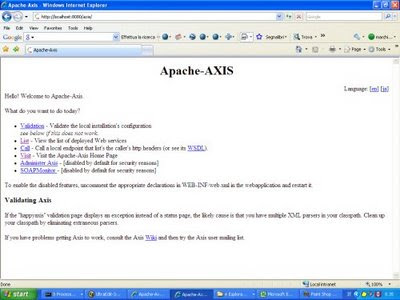Apache Axis is an implementation of the SOAP (“Simple Object Access Protocol”). This project has been decommissioned in favor of Apache CXF, therefore it is highly recommended that you migrate your Axis Web services to Apache CXF.
If you need to use Axis Web services in a recent JBoss EAP / WildFly application, you should at least exclude the webservices subsystem in your jboss-deployment-structure.xml as follows:
<jboss-deployment-structure xmlns="urn:jboss:deployment-structure:1.2">
<deployment>
<exclude-subsystems>
<subsystem name="webservices"/>
</exclude-subsystems>
</deployment>
</jboss-deployment-structure>
This approach is however discouraged as the Axis libraries have not been tested with JDK 1.8 which is the bare minimal requirement to start WildFly / JBoss EAP 7.
As a reference, we include an Axis tutorial for JBoss 5.
Using Apache Axis with JBoss 5
Still not ready for JBoss WS ? if you don’t have a JDK 1.5 compliant environment then consider using Axis as your Web Service Engine. It’s robust, stable and easy to setup.
Axis is essentially a SOAP engine, that is a framework for constructing SOAP processors such as clients, servers, gateways, etc. The first thing to do is installing Axis engine on JBoss.
Installing Axis on JBoss
At first download Axis from the Apache project: http://ws.apache.org/axis/java/index.html
Explode the zip folder. Now you need to deploy the Axis engine to JBoss Web Engine (Tomcat).
Here’s how to do it: rename the folder axis under AXIS_HOME/webapps to axis.war and copy the folder under “deploy” of your JBoss
package test;
public class HelloWorld {
public String hello(String message) {
return "Invoked with" +message;
}
}
At first compile the class :
javac -d . HelloWorld.java
Now copy the class under WEB-INF/classes of your axis.war
Ok, now the last step is registering your Web Service so that Axis is aware of it. A Web Service can be registered with a Deployment Descriptor (WSDD) file. A deployment descriptor contains a bunch of things you want to “deploy” into Axis – i.e. make available to the Axis engine.
Here’s a simple wsdd file for our WebService:
<deployment xmlns="http://xml.apache.org/axis/wsdd/" xmlns:java="http://xml.apache.org/axis/wsdd/providers/java"> <service name="HelloWorld" provider="java:RPC"> <parameter name="className" value="test.HelloWorld"/> <parameter name="allowedMethods" value="*"/> </service> </deployment>
Pretty simple, really – the outermost element tells the engine that this is a WSDD deployment,and defines the “java” namespace. Then the service element actually defines the service for us. A service is a targeted chain which means it may have any of: a request flow, a provider, and a response flow.
In this case, our provider is “java:RPC”, which is built into Axis, and indicates a Java RPC service. We need to tell the RPCProvider that it should instantiate and call the correct class (e.g. test.HelloWorld), and another to tell the engine that any public method on that class may be called via SOAP (that’s what the “*” means)
Now save your wsdd file as deploy.wsdd and run the AdminClient which is an Utility to deploy the WebService:
java -classpath %AXIS_HOME%/lib/axis.jar;%AXIS_HOME%/lib/commons-discovery-0.2.jar;%AXIS_HOME%/lib/commons-logging-1.0.4.jar;%AXIS_HOME%/lib/saaj.jar;%AXIS_HOME%/lib/jaxrpc.jar org.apache.axis.client.AdminClient deploy.wsdd
If everything was Ok now you should see the WebService deployed on Axis: check the “List” option from the URL http://localhost:8080/axis/
The client
Let’s take a look at an example Web Service client that will call the hello method of the HelloWorld Web Service :
package test;
import org.apache.axis.client.Call;
import org.apache.axis.client.Service;
import javax.xml.namespace.QName;
import java.net.URL;
public class Client {
public static void main (String args[]) {
try {
String url;
url="http://localhost:8080/axis/services/HelloWorld";
Service service = new Service();
Call call = (Call)service.createCall();
call.setTargetEndpointAddress(new URL(url));
call.setOperationName(new QName("HelloWorld", "hello"));
Object[] params = new Object[1];
params[0] = "Hello Message";
Object result = call.invoke(params);
System.out.println("result is " + result);
}
catch(Exception e) {
e.printStackTrace();
}
}
}
call.setTargetEndpointAddress(new URL(url));
With this we define the operation (method) name of the Web Service.
call.setOperationName(new QName("HelloWorld", "hello"));
Then we actually invoke the desired service, passing in an array of parameters – in this case just one String.
Object result = call.invoke(params);
Obtaining WSDL for deployed services
<?xml version="1.0" encoding="UTF-8" ?> <wsdl:definitions targetNamespace="http://localhost:8080/axis/services/HelloWorld" xmlns:apachesoap="http://xml.apache.org/xml-soap" xmlns:impl="http://localhost:8080/axis/services/HelloWorld" xmlns:intf="http://localhost:8080/axis/services/HelloWorld" xmlns:soapenc="http://schemas.xmlsoap.org/soap/encoding/" xmlns:wsdl="http://schemas.xmlsoap.org/wsdl/" xmlns:wsdlsoap="http://schemas.xmlsoap.org/wsdl/soap/" xmlns:xsd="http://www.w3.org/2001/XMLSchema"> <wsdl:message name="helloRequest"> <wsdl:part name="in0" type="xsd:string" /> </wsdl:message> <wsdl:message name="helloResponse"> <wsdl:part name="helloReturn" type="xsd:string" /> </wsdl:message> <wsdl:portType name="HelloWorld"> <wsdl:operation name="hello" parameterOrder="in0"> <wsdl:input message="impl:helloRequest" name="helloRequest" /> <wsdl:output message="impl:helloResponse" name="helloResponse" /> </wsdl:operation> </wsdl:portType> <wsdl:binding name="HelloWorldSoapBinding" type="impl:HelloWorld"> <wsdlsoap:binding style="rpc" transport="http://schemas.xmlsoap.org/soap/http" /> <wsdl:operation name="hello"> <wsdlsoap:operation soapAction="" /> <wsdl:input name="helloRequest"> <wsdlsoap:body encodingStyle="http://schemas.xmlsoap.org/soap/encoding/" namespace="http://test" use="encoded" /> </wsdl:input> <wsdl:output name="helloResponse"> <wsdlsoap:body encodingStyle="http://schemas.xmlsoap.org/soap/encoding/" namespace="http://localhost:8080/axis/services/HelloWorld" use="encoded" /> </wsdl:output> </wsdl:operation> </wsdl:binding> <wsdl:service name="HelloWorldService"> <wsdl:port binding="impl:HelloWorldSoapBinding" name="HelloWorld"> <wsdlsoap:address location="http://localhost:8080/axis/services/HelloWorld" /> </wsdl:port> </wsdl:service> </wsdl:definitions>
Generating Java Classes from WSDL
Another approach is to generate Java Classes starting from WSDL contract. You can use the AdminClient to follow this approach:
java -classpath %AXIS_HOME%/lib/wsdl4j-1.5.1.jar;%AXIS_HOME%/lib/axis.jar;%AXIS_HOME%/lib/commons-discovery-0.2.jar;%AXIS_HOME%/lib/commons-logging-1.0.4.jar;%AXIS_HOME%/lib/saaj.jar;%AXIS_HOME%/lib/jaxrpc.jar org.apache.axis.wsdl.WSDL2Java http://localhost:8080/axis/services/HelloWorld?wsdl
This will generate the following classes under the service namespace which is localhost\axis\services\HelloWorld :
HelloWorld.java HelloWorldService.java HelloWorldServiceLocator.java HelloWorldSoapBindingStub.java
Generating Java Classes from the WSDL is defined as “top-down” approach, while generating WSDL from Java classes is called “bottom-up” style.
Although bottom-up Web service development may be faster and easier, especially if you are new to Web services, the top-down approach is the recommended way of creating a Web service. By creating the WSDL file first you will ultimately have more control over the Web service, and can eliminate interoperability issues that may arise when creating a Web service using the bottom-up method.
Found the article helpful? if so please follow us on Socials